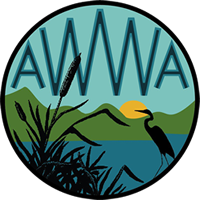As you know from reading this blog, I like the snow and I love winter. I suppose I am one of those “weird” people who list winter as their favorite season. I like the cold, the peace and quiet, and the outdoor activities, but none of that is as fun without the snow! Whenever I think back on last winter, I remember bare ground till January, a couple little storms, 50’s at the beginning of March and no more snow by about that same time. That’s what I call a sad winter! This winter, for me, was at least a little more reminiscent of the winters I remember as a child, especially that super storm when we got 30″! You just can’t beat the beauty of snow covered trees and white as far as they eye can see.
Now that I have had my little nostalgic moment, why, you may ask, am I talking about snow as we watch the last remaining piles melt away and we officially welcome spring? Simple. In the water field/business/industry we watch this time of year very closely. Why? All that snow out there will melt and become runoff. How much snow we have, how much it packed down, the daily temperatures, rain events, and, most importantly, what is in the snow are going to influence our streams, rivers, ponds, lakes, and oceans.
When it rains in the summer, we see the rain flow down our roads, driveways, and properties in channels, small rivers, or as a sheet across the land. When snow melts, it tends to be less obvious how much runoff is happening. Unless we have a rain storm or a really, really warm day while the snow is still out, we don’t really see too much erosion happening and runoff is usually in small little channels. But what about whats already in the snow?
 This is a great example of what we can see in our snow and how we tend to deal with our snow melt. This picture, from the Neponset River in MA, shows how a lot of our urban snow is dealt with and how it can influence our surface waters as much as a summer rainstorm. This snow pile has been made through an entire winter of plowing. All those wonderful things that are on our roads and parking lots get locked up in a deep freeze for the winter and then, in a few weeks during the spring, are released to our waters.
This is a great example of what we can see in our snow and how we tend to deal with our snow melt. This picture, from the Neponset River in MA, shows how a lot of our urban snow is dealt with and how it can influence our surface waters as much as a summer rainstorm. This snow pile has been made through an entire winter of plowing. All those wonderful things that are on our roads and parking lots get locked up in a deep freeze for the winter and then, in a few weeks during the spring, are released to our waters.
Let me just take a minute to detail what the water quality of snow melt looks like. To start with, snow flakes themselves are formed around dust particulates and aerosol pollutants in the atmosphere. After the snow has reached the earth, it undergoes anything from plowing, to shoveling, to remaining untouched in a field. In all of these scenarios, the snow pack is subject to continual deposition from urban emissions (sulfates, nitrates, metals) as well as long range transport of pollutants from power plants. On top of that , studies have found atmospheric deposition from toxic compounds, nutrients,and solids from fossil fuel combustion, incineration, chemical processing, metal plating, and manufacturing (watershed protection techniques).
So, now we know all the hidden terrors that potentially exist in our snowpacks. The amount of “stuff” in the snow as it begins to melt can be detrimental to surface waters. If the snow melted very slowly and continually than these concentrations would be spread out evenly, but that isn’t how it happens. On top of that, the ground remains frozen for part of this process and infiltration cannot happen, therefore the runoff is guaranteed to make it to a waterbody.
Unfortunately, these processes are not limited to urban areas. In forested settings, atmospheric deposition still occurs and leaves behind chemicals and toxins, but in far less concentration. What tends to happen is that trees along the edge of a forest accumulate the toxins in their needles and branches while the inner forest remains far less effected.
Unfortunately, there is not a whole lot we can really do about snowmelt, but it is important to know that the melting snow is contributing an interesting concoction of chemicals to our surface waters. For more information, see Influences of Snowmelt Dynamics on Stormwater Runoff Quality.


